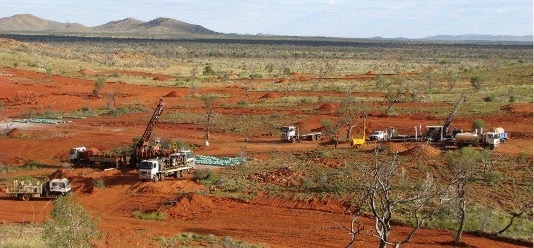Redstone Resources Limited (ASX: RDS) has confirmed the previously reported hh‐pXRF analyses with new assays from the 100% owned Tollu Project located in the south-east portion of the West Musgrave region of Western Australia.
The assays show that the reverse circulation (RC) drilling completed at the end of 2021 has successfully proved that thick high‐grade lenses of copper mineralisation intersected in historical drilling at the Chatsworth Prospect at Tollu have significant volume vertically and extend to shallower depths.
The West Musgrave Project, which includes the Tollu Cu Vein deposit, is located 40 km east of the world‐class Nebo‐ Babel nickel‐copper‐PGE sulphide deposit now owned by OZ Minerals and has the ideal geological and structural setting for large magmatic Ni‐Cu sulphide deposits.
At the end of 2021 four reverse circulation (RC) drill holes, TLC188, TLC189, TLC190 and TLC192, for a total of 756m were drilled at the Chatsworth Prospect.
The aim of the drilling was to test for continuity of mineralisation vertically through the hosting sub‐vertical vein system, and in doing so, test if the thick high grade copper mineralisation previously intersected in early drilling held volume between and beyond the historical drill holes, particularly at shallower depths than previously intersected.
Preliminary results of the drilling using hh‐pXRF analyse.
Geochemical assays have successfully confirmed these preliminary results, with generally higher Cu grades than the hh‐pXRF analyses but with slightly varying thicknesses.
Drill holes TLC188 and TLC189, targeted approximately 15‐20m vertically above a high grade copper intersection in historical drill hole TLC033, drilled in 2010 and 25‐30m vertically below another high grade intersection in historical drill hole TLC034, also drilled in 2010.
The historical drill holes suggest the mineralisation extends vertically between them but the vertical distance between the intersections is some 35m, a considerable distance for vein hosted mineralisation.
The geochemical assays from TLC188 and TLC189 have confirmed that the thick high grade copper mineralisation continues vertically, being maintained in the deeper intersection with 10m at 2.51% Cu from 174m downhole, including 3m at 4.71% Cu from 175m downhole (in TLC188) and swelling in the shallower intersection with 26m at 1.46% copper from only 61m downhole, inclusive of 1m at 5.1% Cu from 67m downhole (in TLC189).
TLC188 and TLC189 have extended the vertical continuity of the copper mineralisation to double previous with at least some 100m of vertical extent, seemingly continuous and still open at depth and towards the surface. What previously seemed a contraction of mineralisation towards the surface in TLC033, is most likely a ‘pinch’ in a pinch and swell morphology.
Drill hole TLC192, positioned some 90m to the south of TLC188 and TLC189, has successfully extended the high grade copper mineralisation intersected in historical drill holes TLC024, TLC031 and TLC030 vertically towards the surface.
Geochemical assays confirm the intersection of copper mineralisation in TLC192 is 25m thick grading 1.1% Cu from 53m downhole, which includes 7m at 2.64% Cu from 60m downhole. The shallow extension of mineralisation by TLC192 extends the high-grade mineralisation in this location to some 120m vertically and is open towards the surface
The 2021 RC drilling has shown that whilst there is some complexity in the mineralisation at Chatsworth, as may be expected in a vein hosted system, the thick high‐grade copper mineralisation intersected in the drilling holds volume between historical drill holes and extends beyond that which has been intersected by drilling to date.
The drilling has also highlighted that there may be opportunities in the Tollu resource not yet realised and which may need to be investigated.
For further information please visit: http://www.redstone.com.au/












